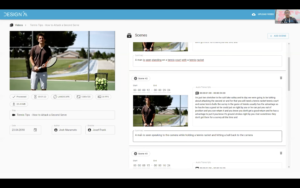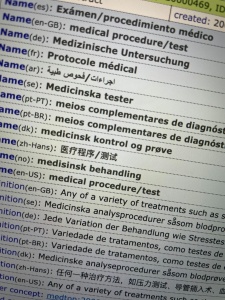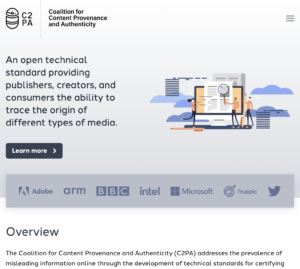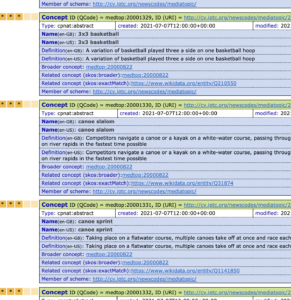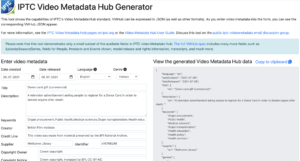Categories
Archives
IPTC members and our guests have just finished a very busy 2021 edition of our IPTC Autumn Meeting. Held online over three days, the meeting was a mix of IPTC Working Group presentations, members presenting recent projects, and invited guest speakers on important topics in the news and media world.
This year we heard member presentations from:
- Honor Craig-Bennett of the BBC reporting on the Images Digital Asset Management system, based on the Guardian’s open-source GRID system. We heard from Andy Read about this system
- Heather Edwards from Associated Press spoke about their project to replace their existing rules-based classification system
- Mark Milstein from Microstocksolutions spoke about a new project he is working on to create “synthetic media” AI-generated images and videos based on textual descriptions and metadata
- DATAGROUP Consulting Group’s Robert Schmidt-Nia spoke about a project using AWS’s Comprehend text classification service to power a serverless news classification system using IPTC’s Media Topics vocabulary
- Frameright‘s Marina Ekroos speaking about an EU stars4media project they are working on called “Artificial Intelligence in photojournalism: can it work?”
- Scott Yates from new Startup Member JournalList spoke about the trust.txt project, letting news providers state their affiliates and official social media channels in a simple way
- Bruce MacCormack from CBC / Radio Canada spoke about Project Origin, looking at authenticity for video and news media, passing requirements to the C2PA work
- The BBC‘s Charlie Halford spoke about C2PA, updating members with a deep technical view on how the system is planned to work, as detailed in the recently-released draft specification.
In addition, we heard from guest speakers:
- Keesiu Wong of Design AI spoke about the Videre AI project, looking at “next-generation video understanding”. He was joined by project partner Javier Picazo from Associate Member Agencia EFE, Spain’s national news agency.
- Alex Lakatos of Interledger spoke about the distributed payments technology which is used by…
- Uchi Uchibeke of Coil who use Interledger to implement micropayments which can be implemented on publisher websites by adding one line of HTML.
New standard versions
The Working Group presentations were also packed with content, in particular three new standard versions that were proposed to the Standards Committee:
- NewsML-G2 v2.30 adds fields for “residrefformat” and “residrefformaturi” to enable publishers to describe the format of a resource ID reference, and makes catalog and catalogRef optional to support publishers who only use URIs for controlled values and therefore have no need for catalogs
- The News in JSON Working Group’s ninjs v2.0 is a non-backwards-compatible new release which changes the way repeating values are handled, moving from patternProperties fields with arbitrary names such as “body_text” and “body_html” to arrays with fixed names such as “bodies”. The objects within the array elements include properties “role” and “contenttype” which take the place of the arbitrary extension to the “body_” tag.
- The IPTC Photo Metadata Standard v2021.1 adds new properties to IPTC Core which are intended to be used for accessibility purposes: “Alt Text (Accessibility)” and “Extended Description (Accessibility)”. We have also added and Event Identifier property to align with other metadata ID properties, and modified the Description Writer field to include the writer of the accessibility fields.
New faces
We were very happy to welcome new members Frameright, JournalList, Spotlight Sports Group, Glide Publishing Platform to the meeting.
The Standards Committee was chaired for the first time by new Chair Paul Harman of Bloomberg.
The AGM was the first for new Treasurer, Gerald Innerwinkler of Austria Press Agentur APA.
And we congratulate Philippe Mougin of Agence France-Presse AFP for being voted on to the IPTC Board of Directors, along with the existing Board members who were all re-elected.
It was another great meeting with over 70 representatives from 42 organisations in 17 different countries! We’re hoping that the next IPTC member meeting will be back to face-to-face, and we have provisionally booked Tallinn, Estonia for 16 – 18 May, 2022. We will confirm this in January 2022.
We are proud to announce the upcoming IPTC Photo Metadata Conference. This year’s event will be held online on Thursday 4th November 2021 as a Zoom webinar, free for anyone to attend, whether you are an IPTC member or not.
We are very happy to be hosting speakers from:
- the Smithsonian Institution, Macmillan Learning, Morey Creative Studios and Level Access speaking about accessibility for images on today’s web
- Adobe and the Content Authenticity Initiative speaking about content authenticity and provenance and the forthcoming C2PA specifications
- Michael Steidl from IPTC’s Photo Metadata Working Group introducing IPTC’s new tools to measure and compare the interoperability of photo metadata tools.
The event will run from 1500 to 1900 UTC, which is:
- 1500 to 1900 in the UK, Ireland and Portugal
- 1600 to 2000 in Central Europe
- 1700 to 2100 in Eastern Europe and Israel
- 1100 to 1500 in US East Coast
- 0800 to 1200 in US West Coast
- 2300 to 0300 in China
- 0200 to 0600 on Australia’s East Coast (sorry about that!)
See more information and register at https://iptc.org/events/photo-metadata-conference-2021/ or simply register using this link.
The webinar will be recorded, and those who register but can’t attend will be sent a link to the video so that they can watch the recording afterwards.
After registering, you will be emailed with a calendar invitation and a Zoom webinar link.
We’re looking forward to seeing you there!
We have just released the Q3 update to Media Topics, IPTC’s subject taxonomy used for classifying news content.
Most were changes to the education branch, following our regular review cycle. We also added some missing Norwegian translations (thanks to Tor Kristian Flage at NTB) and fixed some incorrect Wikidata mappings.
The changes are listed below. All changes are in both en-GB and en-US versions unless otherwise noted.
New terms:
- medtop:20001337 online and remote learning
Label changes:
- medtop:20000398 parent organisation -> parents group
- medtop:20001215 independent schools -> independent school (en-GB), independent and charter school (en-US)
- medtop:20000409 preschool -> early childhood educatio
- medtop:20001214 private schools -> private school
- medtop:20001213 public schools -> public school (en-US), state school (en-GB)
- medtop:20000403 adult education -> adult and continuing education (definition also changed, and moved to become a child of medtop:20000400 school)
- medtop:20000413 examination -> educational testing and examinations (definition also changed, and moved to be a child of medtop:05000000 education)
- medtop:20000405 higher education -> college and university (definition also changed)
- medtop:20000401 elementary schools -> primary education (definition also changed)
- medtop:20000408 middle schools -> lower secondary education (definition also changed)
- medtop:20000404 high schools -> upper secondary education (definition also changed)
- medtop:20001212 religious schools -> religious school (definition also changed)
Definition changes:
- medtop:05000000 education
- medtop:20000399 religious education
- medtop:20000400 school
- medtop:20000410 social learning
- medtop:20001216 vocational education
- medtop:20001217 educational grading (also moved to be a child of medtop:05000000 education)
- medtop:20000414 entrance examination (also moved to be a child of medtop:05000000 education)
- medtop:20000415 students (also moved to become a child of medtop:05000000 education)
- medtop:20000416 teachers (also moved to become a child of medtop:05000000 education)
Hierarchy change (in addition to those listed above):
- medtop:20000412 curriculum: moved to become a child of medtop:05000000 education
Retired terms:
- medtop:20000030 music theatre (its children are moved up to become children of medtop:20000029 theatre)
- medtop:20000411 teaching and learning (its children are now become children of medtop:05000000 education )
- medtop:20000406 college
- medtop:20000407 university
- medtop:20000402 further education
As usual, the Media Topics vocabularies can be viewed in the following ways:
- In a collapsible tree view
- As a downloadable Excel spreadsheet
- On one page on the cv.iptc.org server
- In machine readable formats such as RDF/XML and Turtle using the SKOS vocabulary format: see the cv.iptc.org guidelines document for more detail.
For more information on IPTC NewsCodes in general, please see the IPTC NewsCodes Guidelines.
Next Tuesday, IPTC will be part of a panel of guests speaking at a webinar hosted by CEPIC (the Coordination of European Picture Agencies – Stock, Press and Heritage) and EANA (the European Alliance of News Agencies).

Brendan Quinn, Managing Director of IPTC will be joining the webinar to talk about IPTC’s involvement in C2PA, the Coalition for Content Provenance and Authenticity, in particular the draft technical specification which was released this month. Brendan will be talking about how C2PA aims to solve part of the problem around news provenance, informing users when news comes from a reputable source.
The other speakers are Mathieu Desoubeaux from IMATAG, Stefan Voss, Verification Officer at dpa, and Yacine Le Forestier, Head of Europe fact checking at AFP.
The other speakers are all from IPTC member organisations, and IPTC shares many members with both CEPIC and EANA, so we are very happy to take part in this event.
Registration for the event is still available. The webinar will take place on Tuesday 21 September from 1700 to 1800 CET, but is open before and after for attendee networking and discussion.
As previously announced, the IPTC are participating in the Coalition for Content Provenance and Authenticity (C2PA) project to create a specification to tackle online disinformation and misinformation.
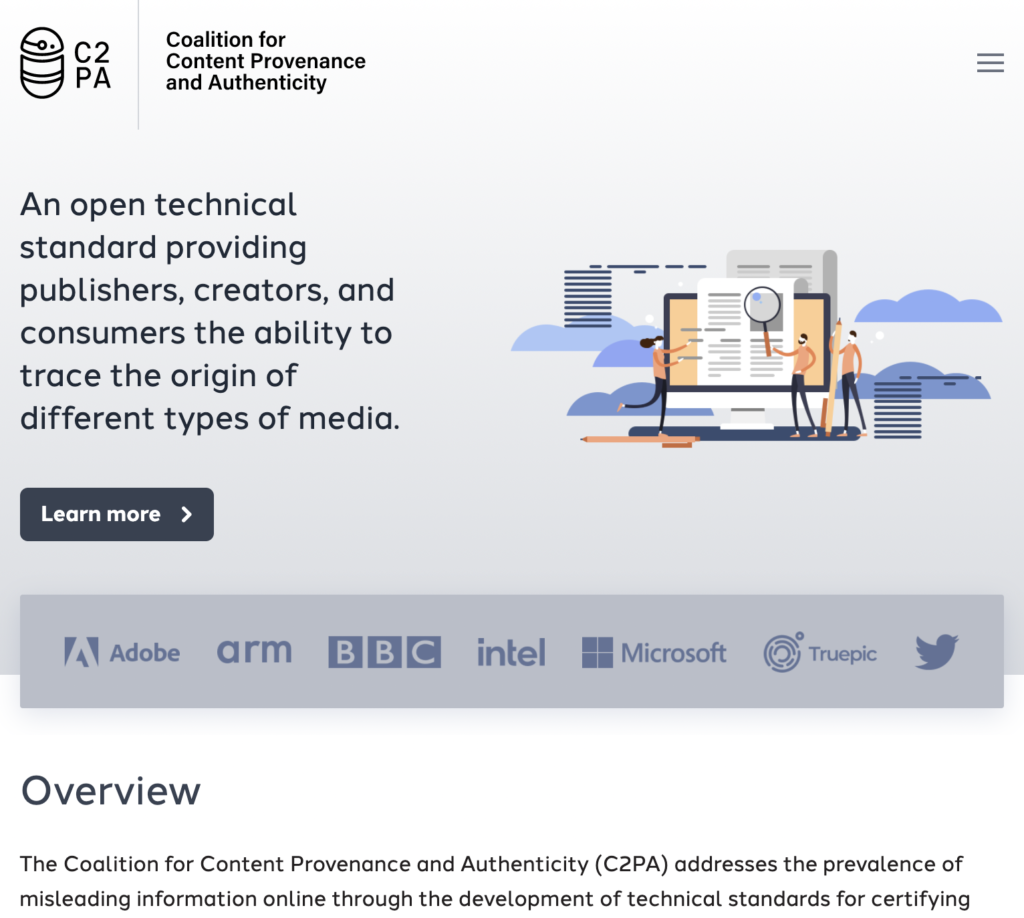
After months of work by the C2PA Technical Working Group, the first public draft of the specification has been released. In particular, the spec defines how properties from the IPTC Photo Metadata Standard can be included in a C2PA manifest, creating a provenance trail that allows future viewers to validate the authenticity of a claim associated with a media asset (such as the location the photo was taken, the creator’s name or who is the person in a photo).
The full press release from C2PA follows:
SAN FRANCISCO, Calif. — September 1, 2021 — Today, the Coalition for Content Provenance and Authenticity (C2PA), a Joint Development Foundation project established to scale trust in online content, released its content provenance specifications – in draft form – for community review and feedback. Driven by a commitment to tackle online disinformation, the C2PA’s technical specifications are designed to be an open standard that will allow publishers, creators and consumers to trace the origin and evolution of a piece of media, including images, videos, audio and documents.
“C2PA was established to accelerate progress toward the broad adoption of content provenance standards that will enable a future of verifiable integrity in media,” said Andrew Jenks, C2PA Chair. “The release of this draft is an exciting and important milestone, representing a diverse and collaborative effort across industries to protect people from fabricated and manipulated media and drive transparency in the origin and history of content.”
Combatting online content fraud at scale requires transparency and an accessible and open approach that enables consumers to make informed decisions about what has been modified and what has not. The C2PA was launched in February 2021 with founding members Adobe, Arm, BBC, Intel, Microsoft and Truepic with the goal of developing an end-to-end open technical standard to address the rise of disinformation efforts leveraging tools for media fabrication and manipulations. The effort has expanded, bringing in additional members including Twitter, WITNESS, Akamai and Fastly.
Over the past six months, the C2PA has worked with industry experts and partner organizations, including the Project Origin Alliance and the Content Authenticity Initiative (CAI), to develop a standard for digital provenance that provides platforms with a method to define descriptive metadata, what information is associated with each type of asset, how that information is presented and stored, and how evidence of tampering can be identified. This group of contributors spans a spectrum of industries including social media, news publishing, software technology, semiconductors and more. All have contributed to building these new technical specifications through a process of gathering requirements, considerations of scenarios and technical design.
Following the review period, the C2PA working groups will finalize the 1.0 version of the technical standards and once published, the group will pursue adoption, prototyping and communication through coalition members and other external stakeholders, providing the foundation for a system of verifiable provenance on the internet.
“The power of C2PA’s open standard will rely on its broad adoption by producers and custodians of content, which makes this review phase so critical to the development and finalization of the specifications,” said Jenks. “This is why we are making the draft specification available to the public. We encourage rigorous review and feedback across industries, civil society, academia, and the general public to ensure the C2PA standards reflect the complex nature of this effort.”
The draft specification can be accessed through the C2PA website, and comments will be accepted through a web submission form and GitHub until November 30, 2021.
C2PA is accepting new members. To join, visit https://c2pa.org/membership/.
About C2PA
The Coalition for Content Provenance and Authenticity (C2PA) is an open, technical standards body addressing the prevalence of misleading information online through the development of technical standards for certifying the source and history (or provenance) of media content. C2PA is a Joint Development Foundation project, formed through an alliance between Adobe, Arm, BBC, Intel, Microsoft and Truepic. For more information, visit c2pa.org.
The IPTC is very happy to announce that Paul Harman of Bloomberg has accepted the Board’s nomination to be Chair of the IPTC Standards Committee.
The IPTC Standards Committee is the core of the technical standardisation work of the news industry. It is the parent of all of the IPTC’s Working Groups. The Committee comprises all Voting Members and is the forum where specifications and recommendations created by the Working Groups are formally approved for publication.
Paul has been an active member of the IPTC for more than two decades. He has worked as a senior software engineer in the industry for over twenty years, first at the Press Association (now PA Media) and more recently at Bloomberg, representing both firms as an IPTC delegate. Paul works primarily on editorial content management systems, syndication platforms, web sites and services, and was active in the development of IPTC’s NewsML v1 and NewsML-G2 standards. He was voted onto the IPTC Board of Directors in October 2019.
Robert Schmidt-Nia, Chair of the IPTC’s Board of Directors, said: “I am honoured to welcome Paul who has volunteered to serve as the new chair of our standards committee. His guidance will support IPTC’s mission to develop relevant standards which will help us solve the dramatic changes our industry faces. My gratitude also goes out to Paul’s employer, Bloomberg, in supporting this advancement.”
Paul said: “We live in an interconnected world. As such, it is vital we have a common understanding of the structure of news and media data to facilitate interoperability, while also avoiding misunderstandings and unnecessary duplication of effort. IPTC standards play a key role in supporting this collaborative ecosystem. I am proud to have been asked to chair the IPTC Standards Committee to help continue the important work this organisation performs on behalf of the news technology industry.”
Recently IPTC has been working with many organisations who are creating solutions for the ongoing problem of misinformation and disinformation in news. We are happy to announce that this work continues through IPTC’s liaison relationship with C2PA, the Coalition for Content Provenance and Authenticity.
C2PA was created to unify the efforts of the Adobe-led Content Authenticity Initiative (CAI) which focuses on systems to provide context and history for digital media, and Project Origin, a Microsoft- and BBC-led initiative that tackles disinformation in the digital news ecosystem. C2PA creates technical standards for certifying the source and history (or provenance) of media content.
The IPTC has been working with both the Content Authenticity Initiative and Project Origin in recent years. Andy Parsons from CAI presented at the IPTC Photo Metadata Conference in 2020. IPTC members who are also members of CAI and/or Project Origin include Adobe, BBC, CBC/Radio Canada and The New York Times.
IPTC and C2PA have agreed to share information and allow each organisation to attend the other’s meetings in the areas of technical specifications of file formats, particularly around image and video files; to share knowledge and expertise around newsroom practices and workflows; and to collaborate in the areas of content syndication and distribution.

The IPTC Photo Metadata Standard is widely used by photographers, photo agencies and other photo suppliers around the world. To help photo people use it properly, IPTC has a specification document with a lot of details in document form.
Now, we have released a machine-readable version of the spec that can be consumed directly by software tools.
We call it the IPTC Photo Metadata TechReference. (See below for direct links to the data files.)
The TechReference is a data object containing all the details of the IPTC Photo Metadata technical specifications in the easy-to-use JSON and YAML formats.
The file covers all IPTC properties and structures.
For each property, we specify:
- the property’s formal name
- corresponding identifiers in the ISO XMP and the IPTC IIM formats, if applicable;
- the property’s datatype, such as string, number or a custom property structure like Location; and
- the property identifier that can be used with ExifTool to read or write the metadata property (such as “XMP-dc:creator” for XMP or “IPTC:Creator” for IIM);
- … and a few more details.
We have also published rich documentation about the TechReference data object on the IPTC website. The data objects themselves can be downloaded from the IPTC site by both IPTC members and other interested parties.
Links:
In time for the 2020 Summer Olympics, soon to be held in Tokyo Japan (in 2021), we have released a new version of the Media Topics vocabulary covering all Olympic sports.
As many MediaTopics users don’t use the sports facets system, we wanted to make sure that the top-level Olympic and Paralympic sports were all represented in the main Media Topics vocabulary.
To make this possible, we have made the following changes:
New and changed labels and definitions for Olympics and Paralympics
We have added the following new sport concepts, all under Competition Discipline:
- medtop:20001329 3×3 basketball
- medtop:20001330 canoe slalom
- medtop:20001331 canoe sprint
- medtop:20001332 bmx freesytle
- medtop:20001333 road cycling
- medtop:20001334 track cycling
- medtop:20001335 football 5-a-side
- medtop:20001336 goalball
Modified labels:
- medtop:20001093 weightlifting -> weightlifting and powerlifting
- medtop:20000895 bmx -> bmx racing
We have “unretired” the following term, which was retired in 2017:
- medtop:20001077 marathon swimming
We have moved the following term:
- medtop:20000887 sport climbing to under “competition discipline”
Updated translations
In another major update we have added labels in French, Spanish and Arabic for most recently-added terms. Thanks to Anne Raynaud and her team at Agence France-Presse (AFP) for this contribution.
Another small change is that in the HTML tree view, we now mark retired concepts more clearly by visually striking out their labels and definitions.
We always welcome feedback on IPTC MediaTopics and the other NewsCodes vocabularies on the public discussion list iptc-newscodes@groups.io.
IPTC’s Video Metadata Working Group is happy to announce that the first version of the IPTC Video Metadata Hub Generator tool has been released. It can be used to create IPTC Video Metadata Hub records without any knowledge of the underlying technical metadata schema.
The Video Metadata Hub tool serves as a demonstrator to show how easy it could be to enter metadata for a video using the Video Metadata Hub common video metadata schema. It illustrates the power of Video Metadata Hub to video architects, digital asset managers and developers of video software and systems.
How do I use the Video Metadata Hub Generator?
To use the tool, simply start typing text into fields in the form on the left hand side of the screen. The right-hand side will automatically update showing a JSON version of the VMHub data according to the IPTC Video Metadata Hub JSON schema.
Because one of the features of IPTC Video Metadata Hub is its rich set of mappings to other well-known video formats, we will be adding other output formats such as XML (NewsML-G2), EBUCore, XMP and EIDR.
What can I do with the output?
The resulting JSON file can be used to supply data to IT systems. Alternatively, the generated JSON file can be saved alongside your video assets as a “sidecar”. This usage is explained in the section of the IPTC Video Metadata Hub User Guide called “Using Video Metadata Hub with your video content”.
In the future, we hope that Video Metadata Hub properties will be built into many video editing tools and digital asset management systems, along with a common way of storing the metadata properties embedded into video files. When this has happened, users will be able to fill out standardised metadata fields in one tool and then view the entered metadata when loading that video file into another tool.
The current version of the Video Metadata Hub Generator shows only a small subset of the 91 Video Metadata Hub fields. In the future, we aim to add a control that lets users specify their use case (for example “video archives” or “news agency”) and all of the relevant fields for that use case would be displayed.
For more information, see the IPTC Video Metadata Hub pages on iptc.org or the Video Metadata Hub User Guide.
We are very interested in feedback from users. Join the conversation about this tool on the public iptc-videometadata email discussion group.
